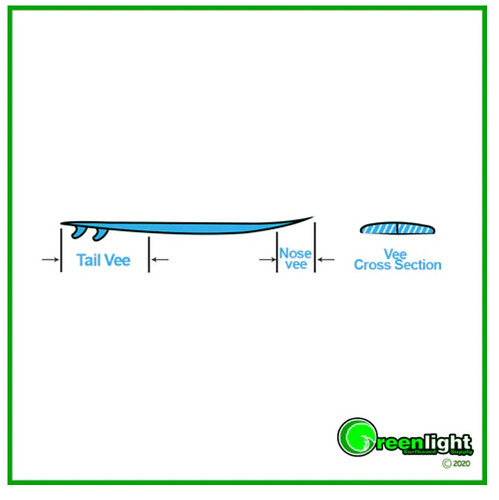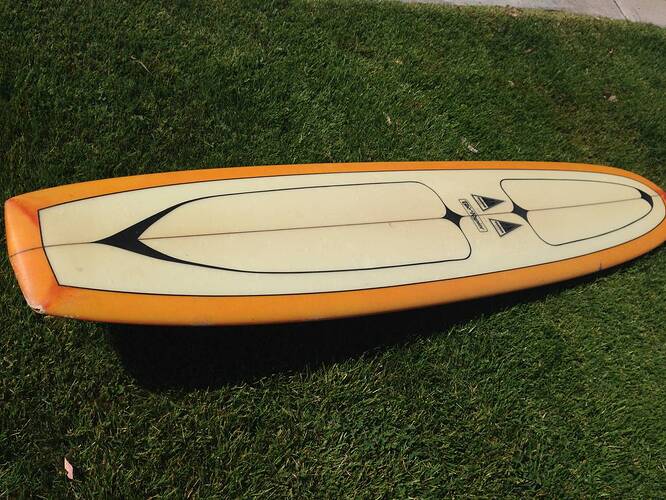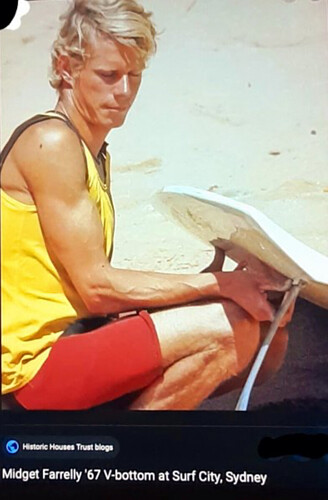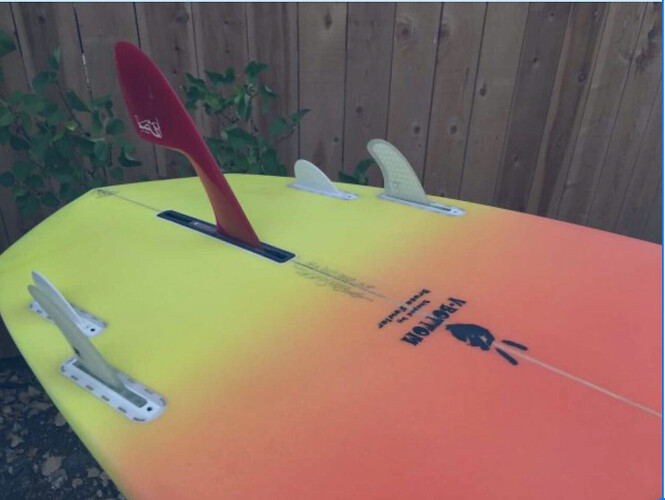I’m shaping a “retro inspired” fish. Original plan was just flat bottom, but the board is pretty chunky (and flat’s just boring) so I’m putting a little bit of vee in the tail to help with turns. Just wondering: how far up the tail should the vee go? My intuition says up to where my back foot would be, but who knows?
I’m curios to hear your take about where “Flat” Vee starts on a Retro Fish. Or perhaps stated as, “What percent of board length is Flat Vee in the tail of a Retro Fish?”
How much Vee depth, 1/4”? More? Less?
I’ve never seen anything definitive about specifics of Flat Vee in a Retro Fish. Just vague allusions…
I’ve seen statements that say 1/2 to 2/3 of board length. These seem high to me and likely to cause tracking. My gestalt-“speculation” would be no more than 40% of board length, starting at the vertex of the butt crack — maybe less because of the half-pin tips length.
Starting 31% of board length up from the vertex of the butt crack?
Flat Vee includes the wings (the 1/2 pin tips on each side of the butt crack)?
My thoughts are from zero at 1/3 to max at front of fins then fade to zero again at the tail. ![]()
Personally, I would want max Vee at the vertex of the butt crack for good tail “pivot” and tracking. Which would be very close to trailing edge of the twin fins.
I’m no pro builder and my Retro inspired Channel Fish eliminates tail Vee.
Tim Stamps claims to be a Fish shaper. Would be curious to know what kind of Vee he would use for a Retro Fish.
It is my understanding that @MRat has some significant shaping experience/insight.
BTW Flat Tail Vee creates fin cant for the twin fins.
An old Sways member, Rooster, gave me several different Retro Fish templates years ago.
Texted him about Tail Vee. No input so far from him either…
Back 1/3 of the board sounds about right, after searching around this forum. I’m sure it depends on how the rocker flows too, which I’ll check out when I see the board next.
I mean, I’m an inexperienced shaper who’s pretty much a longboarder. This will be more of a “learn to shape” exercise. Short blanks are just cheaper.
Headed to the shaping room tonight. My board is 6’, so I’ll do 24’ vee in the back 1/3. Deepest in middle 8" (that’s around where the fins will be); fading to nothing in the 8" on either side. I’m only doing 1/8" of vee. I’ll tape off the borders of the sanded area to maintain symmetry and to keep me from sanding too much. It all should be pretty low impact.
I’ll consider it a win if the board looks good and is somewhat rideable.
Greenlight says Vee in the rear 1/3.
“For me,” I would start Flat/Panel Vee 40% of board length up from the Retro Fish tail tips. With max bottom center Vee at the Vertex of the butt crack — 1/4” deep.
I would be interested in hearing from some of Sways resident pros.
Figure from Greenlight Surf Supply.
Is that from an article? I haven’t seen that yet on Greenlight’s site.
I can only really speak for what I do and I definitely come from more a “performance” shortboard background/mindset so my fish have more of that DNA with the wide point being closer to center than a retro and a bit narrower. I run single, double( starting right behind where your front foot would be) and vee off the last 8 with a slight double in it. I’m using the V to add rail line rocker as well as give me some added hold and flow with the double in it. On eggs and mini guns I go farther up around 1/3 with the V. Make sure it’s smooth and compliments your railing rocker. I see a lot of people just starting to shape make some really abrupt V in wild locations. Keep in mind that You’ll lose some V after lam and hard edge buildup so make sure you add enough to have some effect.
It’s on there site. Scroll down to Panel Vee.
A lot of guys will do either single throughout or some variation of flat to single or belly/flat/ single through fins. My first shape was a hideous, terrible looking fish with flat to slight single and I had a blast on it. Just go for it and keep it simple.
I don’t think I can add any more confusion in answer to your question than already has been done. A common rule amongst good shapers is to “keep it simple”. Limit your “V” to no more forward than where your front food would be in a normal relaxed stance. Not the “spread eagle” “surf school” stance. Keep it soft and refined. Fade it through the fins and out the back. Don’t over think it or make it clunky. Those old exaggerated “V” bottoms didn’t work way back when and they still don’t. They had an exaggerated V model back in those days called the “Klunker”.
I just did it. It’s just a subtle panel vee that flattens out the tail. I can barely see it, but when I run a straight edge across it’s like 1/8-3/16" on each side. It was hard to stop myself from further sanding lol
That was so cool that now I’m thinking of throwing in a little concave up front.
Rails tomorrow. Off topic, but does anybody know how far up the tail the edge should go?
It seems the simplest design aspects of a Retro Fish with Panel/Flat Vee and twin fins were never fully developed.
*Distance from but crack vertex that Vee starts.
*Tail wing (half-pin) extension of Vee.
*Max. Vee depth.
*Point of max. Vee depth.
*Angle of Panel Vee (2-degree vs. 5-degree? Or perhaps more correctly, 176-degree vs. 170-degree).
*Use of Vee angle to create fin cant with a perpendicular fin mount.
So much design information abandoned in favor of (trendy?) dual concave…
(BTW “Spiral Vee” creates drag.)
Everything’s drag. its where all the fun comes from for people who want to do more than go straight.
Skateboard style slashing does not appeal to me.
If I wanted air, I would do gymnastics on a trampoline or go hang gliding.
I’ll take “speed” and maneuverability over drag any day.
I’ll take pressure differential over drag for control.
Spiral Vee creates unnecessary drag.
First tail Vee I saw was with a single fin and wide tail on a 60’s Harbour Rapier. I don’t believe anyone has truly explored, refined and mastered tail Vee.
Plenty of design evolution halted with the creation of thrusters and quads.
Performance is a subjective pereception…
Late ‘60s Harbour Rapier
Midget Farrelly V-Bottom 1967
(Don’t think a single-fin V was the right combo. The Retro Fish twin may be the perfect board for a properly designed Vee tail.)
Bruce Fowler made the V8 in recent years as a tribute to Midget’s V — apparently there were many fans of Bruce’s work.
A Fowler V-Machine
considering the amount you’ve put I think you’re in good shape. Subtle is always good.
In general it’s best to just try something, and then you’ll know.
I would say with a twin fin if you go much more than what you did it becomes more harm than good. But hey, maybe you will like it. That’s all that matters.
I’ve shaped a bunch of convex bottom twin fins, I think they’re great. for me it’s become more about what I want out of a board vs what’s right or wrong.
Something to focus on for you might be your thickness foil, making sure it’s not too blocky in the tail or too thin, maybe about as thick as your pinky at the tail block.
Hard edge is personal preference. Commonly you’ll see it go up to the leading edge of the fin, but certain shapes it could be nose to tail.
There’s got to be a “standard” or “rule of thumb” for edge amount.
My board is 3" thick so far. And 13/16" tail and 11/16" nose. It’s definitely chonky, but it seems proportionate.



